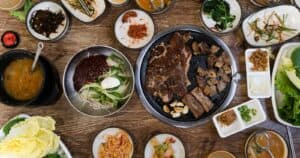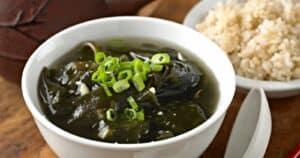Looking for a culinary adventure that will tantalize your taste buds? Look no further than Korean food, a cuisine that stands out for its distinct characteristics and cultural significance. From its fiery spiciness to the art of fermentation, Korean cuisine offers a fascinating blend of flavors and textures that will leave you craving for more.
Whether you’re a fan of communal eating or intrigued by the health benefits of traditional ingredients, Korean food has something to offer for everyone.
The Fiery Flavors: Embracing the Spiciness of Korean Cuisine
Korean cuisine is renowned for its fiery flavors and love for spiciness. This unique aspect of Korean food can be attributed to various key factors that set it apart from other cuisines:
Gochujang: Gochujang, a quintessential ingredient in Korean cuisine, is a spicy and savory fermented condiment made from red chili peppers. Its distinct flavor adds a fiery kick to numerous Korean dishes, making them stand out in terms of spiciness.
Kimchi: Kimchi, a traditional Korean side dish, is another spicy delight. Made from fermented vegetables, it often includes chili pepper flakes or gochujang, giving it a fiery taste. Kimchi is an iconic part of Korean cuisine, loved for its bold spiciness and crunchy texture.
Spicy Rice Cakes (Tteokbokki): Tteokbokki, a popular Korean street food dish, features chewy rice cakes cooked in a spicy sauce. The spiciness of this dish attracts spicy food enthusiasts, offering a tantalizing combination of heat and flavor.
Korean Fried Chicken: Korean fried chicken is famous for its crispy texture and spicy glaze. The glaze is made with gochujang, soy sauce, garlic, and ginger, adding a fiery burst of flavor to the dish. The distinct spiciness of Korean fried chicken makes it stand out and keeps people craving more.
Fire Chicken (Buldak): Buldak is a heavily spiced barbecued chicken dish in Korea, primarily cooked with chili powder and gochujang. It is known for its intense spiciness, often enjoyed with cheese to balance the heat. This fiery dish is a favorite among those who enjoy pushing their taste buds to the limit.
Spicy Stews and Soups: Korean cuisine boasts a wide array of spicy stews and soups, such as kimchi jjigae (kimchi stew) and sundubu jjigae (soft tofu stew). These dishes not only provide warmth and comfort but also deliver a burst of spicy flavors that awaken the senses.
Fermentation: Unveiling the Secrets of Preserving and Enhancing Flavors
Fermentation plays a crucial role in Korean cuisine, both in preserving food and enhancing flavors. It has deep cultural significance and has become an essential part of Korean culinary traditions. Some key points about the uniqueness of Korean food, thanks to fermentation, include:
Iconic Fermented Foods: Korea is known for its various fermented foods that have become representative of the country’s cuisine. These include kimchi, jang, jeotgal, and vinegar. These foods are not only enjoyed as staple ingredients but also as condiments and flavor enhancers.
Kimchi: Kimchi is the most well-known Korean fermented food and showcases the flavors and techniques of fermentation. It is made by fermenting vegetables, primarily cabbage, with a mix of seasonings like chili pepper, garlic, ginger, and fish sauce. The result is a tangy, spicy, and umami-rich dish.
Jang: Fermented soybean products, collectively referred to as jang, play a fundamental role in Korean cooking. Ganjang (soy sauce), doenjang (soybean paste), and gochujang (fermented chili paste) are examples of jang and add depth and complexity to dishes, bringing out unique flavors and enhancing overall taste.
Jeotgal: Salted and fermented seafood, known as jeotgal, is another key component of Korean cuisine. It is made by salting and fermenting various types of seafood, such as shrimp, anchovies, and clams. Jeotgal is used as a condiment or side dish, providing a salty and savory flavor profile to complement other dishes.
Vinegar: Korean cuisine also utilizes fermented vinegar to add a refreshing and sour taste to various dishes. Preparation involves alcohol fermentation followed by acetic fermentation using acetic acid bacteria. Vinegar is used in dressings, marinades, and soups, bringing a tangy element to the flavor palette.
Nutritional Wonders: Discovering the Health Benefits of Korean Cuisine
Korean cuisine is renowned for its unique flavors and numerous health benefits. With a focus on healthy ingredients, low saturated fat, and traditional cooking techniques, Korean food offers a range of advantages for the body and soul.
First and foremost, Korean cuisine stands out for its use of healthy ingredients. Tofu, beans, garlic, and kimchi are staple foods in Korean dishes, all of which are packed with vitamins, minerals, and antioxidants necessary for maintaining good health. These ingredients contribute to a nutrient-rich diet, promoting overall well-being.
Additionally, Korean cuisine is low in saturated fat, which is beneficial for cardiovascular health. Lean proteins like chicken breasts, lean beef, and fatty fishes are preferred in Korean dishes, as they provide essential nutrients while being lower in saturated fat and cholesterol. This emphasis on lean meats ensures a balanced and heart-healthy diet.
Fermented foods play a significant role in Korean cuisine, offering numerous health benefits. Kimchi, jang, jeotgal, and vinegar are commonly consumed as side dishes or ingredients in various dishes. These fermented foods are rich in probiotics, which promote gut health and aid in digestion. Incorporating these foods into one’s diet can contribute to a healthy digestive system.
Korean cuisine also embraces seasonal foods, providing an array of flavors and nutrients throughout the year. With an emphasis on fresh produce that is in season, Korean dishes offer a variety of tastes and nutritional benefits. This emphasis on seasonal eating ensures a diverse and well-rounded diet.
Furthermore, the cooking techniques used in Korean cuisine are healthy ways to prepare food. Grilling, stir-frying, stewing, and fermenting are common cooking methods, which help retain the nutrients and flavors of the ingredients. These methods not only preserve the nutritional value of the food but also add depth and complexity to the final dish.
Finally, Korean culture places a strong emphasis on respecting food and cherishing the elderly. This respect is reflected in strict table manners, allowing younger generations to learn how to respect their elders and appreciate the value of food. Such cultural practices contribute to the holistic experience of enjoying Korean cuisine.
The Joy of Eating Together: Exploring the Communal Dining Culture
Communal dining is a cultural practice that brings people together to share meals and time with others. In Korean culture, communal dining holds special significance and plays a vital role in strengthening social connections within the community. Here’s a closer look at the joy of eating together and what makes communal dining unique:
Strengthening Social Connections: Communal dining in Korean culture is all about putting others first and emphasizing the need for human connection and gratitude for relationships. By serving shared plates and having large portions, individuals show their willingness to share and foster a sense of togetherness and unity.
Sharing and Generosity: Communal dining is a time for people to come together, share food, and express gratitude for the abundance of relationships and connections. It highlights the values of sharing and generosity, creating an atmosphere of warmth and camaraderie.
Family and Community Bonding: Communal dining is closely associated with family and community bonding. It provides an opportunity for family members, friends, and neighbors to gather, share a meal, and engage in meaningful conversations. This strengthens the sense of belonging and creates a supportive and nurturing environment.
Furthermore, communal dining is deeply rooted in cultural traditions and customs, serving as a way to preserve and pass down cultural values, rituals, and culinary heritage from one generation to another. The act of eating together goes beyond just consuming food; it is an experience that brings joy, laughter, and a sense of connection with others.
Rice: The Staple Powerhouse of Korean Meals
Rice is a fundamental part of Korean cuisine, serving as the staple food in almost every meal. It holds symbolic meaning in Korean culture, representing life and prosperity. With a variety of rice options available, each type brings its own unique taste, texture, and nutritional value.
Not only is rice a rich source of carbohydrates and energy, but it is also low in fat and cholesterol, making it a healthy choice for a balanced diet. Beyond its nutritional value, rice holds cultural significance in fostering a sense of togetherness and unity during communal meals. The versatility and creativity of rice are showcased in various Korean dishes, such as bibimbap, jumeok-bap, and ssambap.
Seasonal Sensations: Unearthing the Flavors of Every Season
Korean cuisine is renowned for its seasonal sensations, offering a diverse array of flavors that vary from season to season. Each season brings forth a unique selection of ingredients that contribute to the distinctiveness of Korean food. Let’s explore what makes Korean cuisine so unique and delightful in every season.
Spring is a time of renewal, and Korean cuisine celebrates this with fresh greens and vegetables. Spring onions, garlic, and wild greens take center stage, adding vibrant flavors to dishes. For instance, naengi muchim, a seasoned shepherd’s purse dish, combines the freshness of spring greens with savory seasonings. Kkaennip jeon, pan-fried perilla leaves, offers a light and crispy treat. And kongnamul gukbap, a bean sprout soup with rice, brings forth a comforting and nourishing option.
Summer calls for refreshing and cooling foods to combat the heat. Korean cuisine delivers with dishes like naengmyeon, cold buckwheat noodles that are served with a tangy and refreshing broth. Mul naengmyeon takes it a step further by adding icy noodle soup to the mix, perfect for quenching your thirst on hot summer days. And let’s not forget samgyetang, ginseng chicken soup, which not only cools you down but also boosts your energy levels.
As we transition into fall, hearty and warming foods take center stage. Stews and soups become the go-to choices. Galbitang, a beef short rib soup, offers rich and comforting flavors, perfect for colder weather. Jangajji brings pickled vegetables to the table, adding a tangy and piquant element to your meals. And sanjeok, skewered beef and vegetables, provides a burst of savory goodness with every bite.
Winter brings an array of preserved and fermented foods to the forefront of Korean cuisine. Kimchi, a staple in Korean households, provides a spicy and tangy kick to any meal. Kimchi jjigae, a kimchi stew, is a popular winter dish that warms both the body and soul. Dakbokkeumtang, spicy braised chicken, offers a fiery and flavorful option. And tteokguk, rice cake soup, brings together the heartiness of rice cakes and the comfort of a warm broth.





